Radiocarbon Investigation of the Historic African Baobabs of Omusati, Namibia
Abstract
1. Introduction
2. Material and Methods
2.1. The Four Historic Baobabs and Their Areas
2.2. Architecture of the Four Historic Baobabs
2.3. Investigation of the Four Historic Baobabs
3. Results and Discussion
3.1. Radiocarbon Dates and Calibrated Ages
3.2. Stem Ages and Tree Ages
4. Conclusions
Author Contributions
Funding
Data Availability Statement
Acknowledgments and Ethics Statement
Conflicts of Interest
References
- Wickens, G.E. The Baobab–Africa’s Upside-Down Tree. Kew Bull. 1982, 37, 172–209. [Google Scholar]
- Wickens, G.E.; Lowe, P. The Baobabs: Pachycauls of Africa, Madagascar and Australia; Springer: Dordrecht, The Netherlands, 2008; 498p, ISBN 978-1-4020-6431-9. [Google Scholar]
- Baum, D.A. A systematic revision of Adansonia (Bombacaceae). Ann. Missouri Bot. Gard. 1995, 82, 440–471. [Google Scholar] [CrossRef]
- Baum, D.A.; Small, R.L.; Wendel, J.F. Biogeography and floral evolution of baobabs (Adansonia, Bombacaceae) as inferred from multiple data sets. Syst. Biol. 1998, 47, 181–207. [Google Scholar] [CrossRef]
- Cron, G.V.; Karimi, N.; Glennon, K.L.; Udeh, C.A.; Witkowski, E.T.F.; Venter, S.M.; Assogbadjo, A.E.; Mayne, D.H.; Baum, D.A. One African baobab species or two? Synonymy of Adansonia kilima and A. digitata. Taxon 2016, 65, 1037–1049. [Google Scholar] [CrossRef]
- Petignat, A.; Jasper, L. Baobabs of the World: The Upside-down Trees of Madagascar, Africa and Australia; Struik Publishers: Cape Town, South Africa, 2016; 112p, ISBN 9781775843702. [Google Scholar]
- Gebauer, J.; Adam, Y.O.; Cuni Sanchez, A.; Darr, D.; Eltahir, M.E.S.; Fadl, K.E.M.; Fernsebner, G.; Frei, M.; Habte, T.-Y.; Hammer, K.; et al. Africa’s wooden elephant: The baobab tree (Adansonia digitata L.) in Sudan and Kenya: A review. Gen. Res. Crop. Evol. 2015, 63, 377–399. [Google Scholar] [CrossRef]
- Buchmann, C.; Prehsler, S.; Hartl, A.; Vogl, C.R. The Importance of Baobab (Adansonia digitata L.) in Rural West African Subsistence-Suggestion of a Cautionary Approach to International Market Export of Baobab Fruits. Ecol. Food Nutr. 2010, 49, 145–172. [Google Scholar] [CrossRef]
- Muthai, K.U.; Karori, M.S.; Muchugi, A.; Indieka, A.S.; Dembele, C.; Mng’omba, S.; Jamnadass, R. Nutritional variation in baobab (Adansonia digitata L.), fruit pulp and seeds based on Africa geographical regions. Food Sci. Nutr. 2017, 5, 1116–1129. [Google Scholar] [CrossRef]
- Asogwa, I.S.; Ibrahim, A.N.; Agbaka, J.I. African Baobab: Its Role In Enhancing Nutrition, Health, And The Environment. Trees For. People 2021, 3, 100043. [Google Scholar] [CrossRef]
- Patrut, A.; von Reden, K.F.; Lowy, D.A.; Alberts, A.H.; Pohlman, J.W.; Wittmann, R.; Gerlach, D.; Xu, L.; Mitchell, C.S. Radiocarbon dating of a very large African baobab. Tree Physiol. 2007, 27, 1569–1574. [Google Scholar] [CrossRef]
- Patrut, A.; Mayne, D.H.; von Reden, K.F.; Lowy, D.A.; Venter, S.; McNichol, A.P.; Roberts, M.L.; Margineanu, D. Age and Growth Rate Dynamics of an Old African Baobab determined by Radiocarbon Dating. Radiocarbon 2010, 52, 727–734. [Google Scholar] [CrossRef]
- Patrut, A.; von Reden, K.F.; Van Pelt, R.; Mayne, D.H.; Lowy, D.A.; Margineanu, D. Age determination of large live trees with inner cavities: Radiocarbon dating of Platland tree, a large African baobab. Ann. For. Sci. 2011, 68, 993–1003. [Google Scholar] [CrossRef]
- Patrut, A.; von Reden, K.F.; Mayne, D.H.; Lowy, D.A.; Patrut, R.T. AMS radiocarbon investigation of the African baobab: Searching for the oldest tree. Nucl. Instr. Meth. B 2013, 294, 622–626. [Google Scholar] [CrossRef]
- Patrut, A.; Woodborne, S.; von Reden, K.F.; Hall, G.; Hofmeyr, M.; Lowy, D.A.; Patrut, R.T. African Baobabs with False Inner Cavities: The Radiocarbon Investigation of the Lebombo Eco Trail Baobab. PLoS ONE 2015, 10, e0117193. [Google Scholar] [CrossRef] [PubMed]
- Patrut, A.; Woodborne, S.; von Reden, K.F.; Hall, G.; Patrut, R.T.; Rakosy, L.; Danthu, P.; Leong Pock-Tsy, J.-M.; Lowy, D.A.; Margineanu, D. The growth stop phenomenon of baobabs (Adansonia spp.) indentified by radiocarbon dating. Radiocarbon 2017, 59, 435–448. [Google Scholar] [CrossRef]
- Patrut, A.; Woodborne, S.; Patrut, R.T.; Rakosy, L.; Lowy, D.A.; Hall, G.; von Reden, K.F. The demise of the largest and oldest African baobabs. Nat. Plants 2018, 4, 423–426. [Google Scholar] [CrossRef]
- Patrut, A.; Woodborne, S.; Patrut, R.T.; Hall, G.; Rakosy, L.; Winterbach, C.; von Reden, K.F. Age, growth and death of a National icon: The historic Chapman baobab of Botswana. Forests 2019, 10, 983. [Google Scholar] [CrossRef]
- Patrut, A.; Garg, A.; Woodborne, S.; Patrut, R.T.; Rakosy, L.; Ratiu, I.A.; Lowy, D.A. Radiocarbon dating of two old African baobabs from India. PLoS ONE 2020, 15, e0227352. [Google Scholar] [CrossRef]
- Patrut, A.; Patrut, R.T.; Rakosy, L.; Ratiu, I.A.; Bodis, J.; Nassor, M.N.; von Reden, K.F. Radiocarbon investigation of two large African baobabs from Kizimkazi, Zanzibar, Tanzania. Studia UBB Chemia 2022, LXVII, 143–153. [Google Scholar] [CrossRef]
- Lisao, K.; Geldenhuys, C.J.; Chirwa, P.W. Assessment of the African baobab (Adansonia digitata L.) populations in Namibia: Implications for conservation. Glob. Ecol. Conserv. 2018, 14, e00386. [Google Scholar] [CrossRef]
- Munyebvu, F.; Mapaure, I.; Kwembeya, E.G. Abundance, structure and uses of Baobab (Adansonia digitata L.) populations in Omusati Region, Namibia. S. Afr. J. Bot. 2018, 119, 112–118. [Google Scholar] [CrossRef]
- Patrut, A.; Patrut, R.T.; Rakosy, L.; Rakosy, D.; Ratiu, I.A.; von Reden, K.F. Radiocarbon investigation of the Big baobab of Outapi, Namibia. Studia UBB Chemia 2021, LXVI, 153–163. [Google Scholar] [CrossRef]
- Nampala, L.; Shigweda, V. Aawambo Kingdoms, History and Cultural Change, Perspective from Northern Namibia; P. Schlettwein Publishing: Basel, Switzerland, 2006; pp. 21–64, 73–104. ISBN 978-3908193166. [Google Scholar]
- Dale, R. The Namibian War of Independence, 1966–1989: Diplomatic, Economic and Military Campaigns; McFarland & Company, Incorporated Publishers: Jefferson, NC, USA, 2014; pp. 74–77, 93–95. ISBN 978-0786496594. [Google Scholar]
- Patrut, A.; Patrut, R.T.; Rakosy, L.; Ratiu, I.A.; Lowy, D.A.; von Reden, K.F. Age, growth and architecture of the historic Big Tree at Victoria Falls assessed by radiocarbon dating. Dendrochronologia 2021, 70, 125898. [Google Scholar] [CrossRef]
- Patrut, A.; Patrut, R.T.; Rakosy, L.; Lowy, D.A.; von Reden, K.F. Radiocarbon Dating of the Historic Livingstone Tree at Chiramba, Mozambique. Studia UBB Chem. 2020, LXV, 149–156. [Google Scholar] [CrossRef]
- Bause, T. History of the Ombalantu baobab tree. The Namibian, 31 August 2010; p. 1. [Google Scholar]
- Okahao Baobab National Heritage Site. Ombupupu.Okahao Town Counc. Newsl. 2013, 3, 1–8.
- Oliver, W. The Monumental Baobabs of Owambo. FlyWestair 2020, 43. [Google Scholar]
- Patrut, A.; Garnaud, S.; Ka, O.; Patrut, R.T.; Diagne, T.; Lowy, D.A.; Forizs, E.; Bodis, J.; von Reden, K.F. African baobabs with a very large number of stems and false stems: Radiocarbon investigation of the baobab of Warang. Studia UBB Chem. 2017, LXII, 111–120. [Google Scholar] [CrossRef]
- Loader, N.J.; Robertson, I.; Barker, A.C.; Switsur, V.R.; Waterhouse, J.S. An improved technique for the batch processing of small wholewood samples to α-cellulose. Chem. Geol. 1997, 136, 313–317. [Google Scholar] [CrossRef]
- Sofer, Z. Preparation of carbon dioxide for stable carbon isotope analysis of petroleum fractions. Anal. Chem. 1980, 52, 1389–1391. [Google Scholar] [CrossRef]
- Vogel, J.S.; Southon, J.R.; Nelson, D.E.; Brown, T.A. Performance of catalytically condensed carbon for use in accelerator mass-spectrometry. Nucl. Instr. Meth. B 1984, 5, 289–293. [Google Scholar] [CrossRef]
- Povinec, P.P.; Litherland, A.E.; von Reden, K.F. Developments in Radiocarbon Technologies: From the Libby Counter to Compound-Specific AMS Analyses. Radiocarbon 2009, 51, 45–78. [Google Scholar] [CrossRef]
- Roberts, M.L.; Burton, J.R.; Elder, K.L.; Longworth, B.E.; McIntyre, C.P.; von Reden, K.F.; Han, B.X.; Rosenheim, B.E.; Jenkins, W.J.; Galutschek, E.; et al. A high-performance 14C Accelerator Mass Spectrometry system. Radiocarbon 2010, 52, 228–235. [Google Scholar] [CrossRef]
- Mbele, V.L.; Mullins, S.M.; Winkler, S.R.; Woodborne, S. Acceptance Tests for AMS Radiocarbon Measurements at iThemba LABS, Gauteng, South Africa. Phys. Proc. 2017, 90, 10–16. [Google Scholar] [CrossRef]
- Bronk Ramsey, C. Bayesian analysis of radiocarbon dates. Radiocarbon 2009, 51, 337–360. [Google Scholar] [CrossRef]
- Hogg, A.G.; Heaton, T.J.; Hua, Q.; Palmer, J.G.; Turney, C.S.M.; Southon, J.; Bayliss, A.; Blackwell, P.G.; Boswijk, G.; Ramsey, C.B.; et al. SHCal20 Southern Hemisphere Calibration, 0–55,000 Years cal BP. Radiocarbon 2020, 62, 759–778. [Google Scholar] [CrossRef]
- Hajdas, I.; Ascough, P.; Garnett, M.H.; Fallon, S.J.; Pearson, C.L.; Quarta, G.; Spalding, K.L.; Yamaguchi, H.; Yoneda, M. Radiocarbon dating. Nat. Rev. Methods Primers 2021, 1, 62. [Google Scholar] [CrossRef]

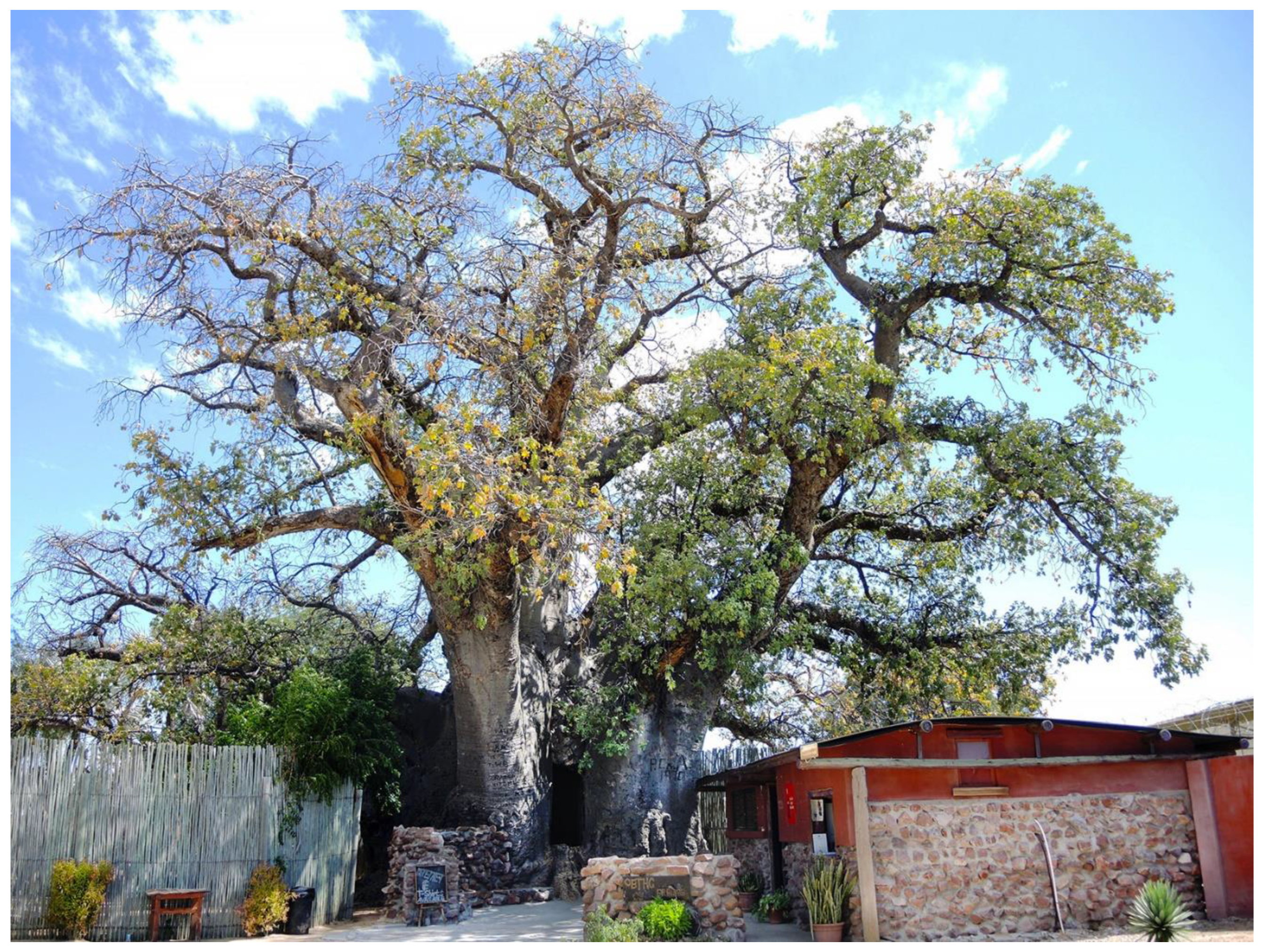
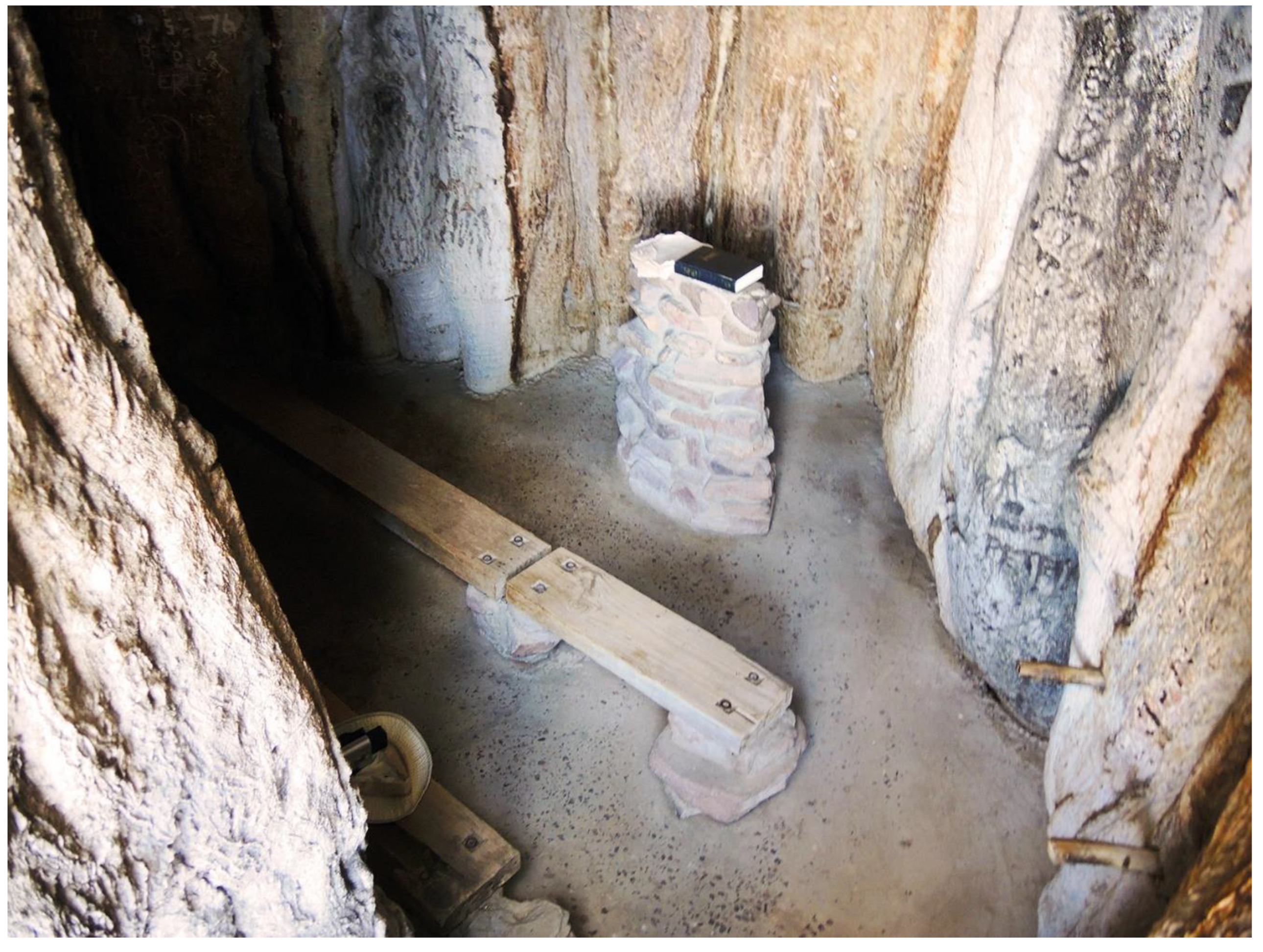
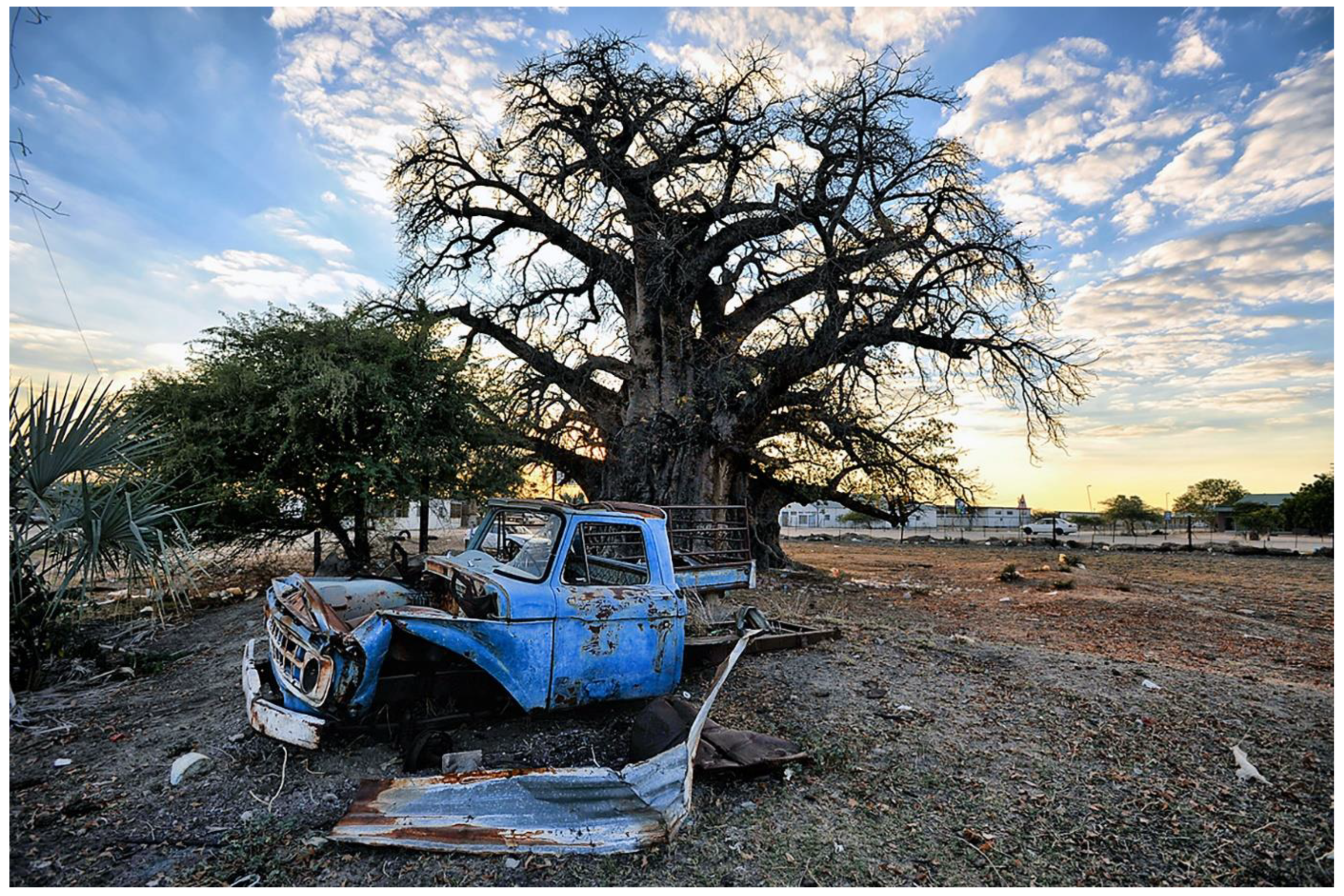
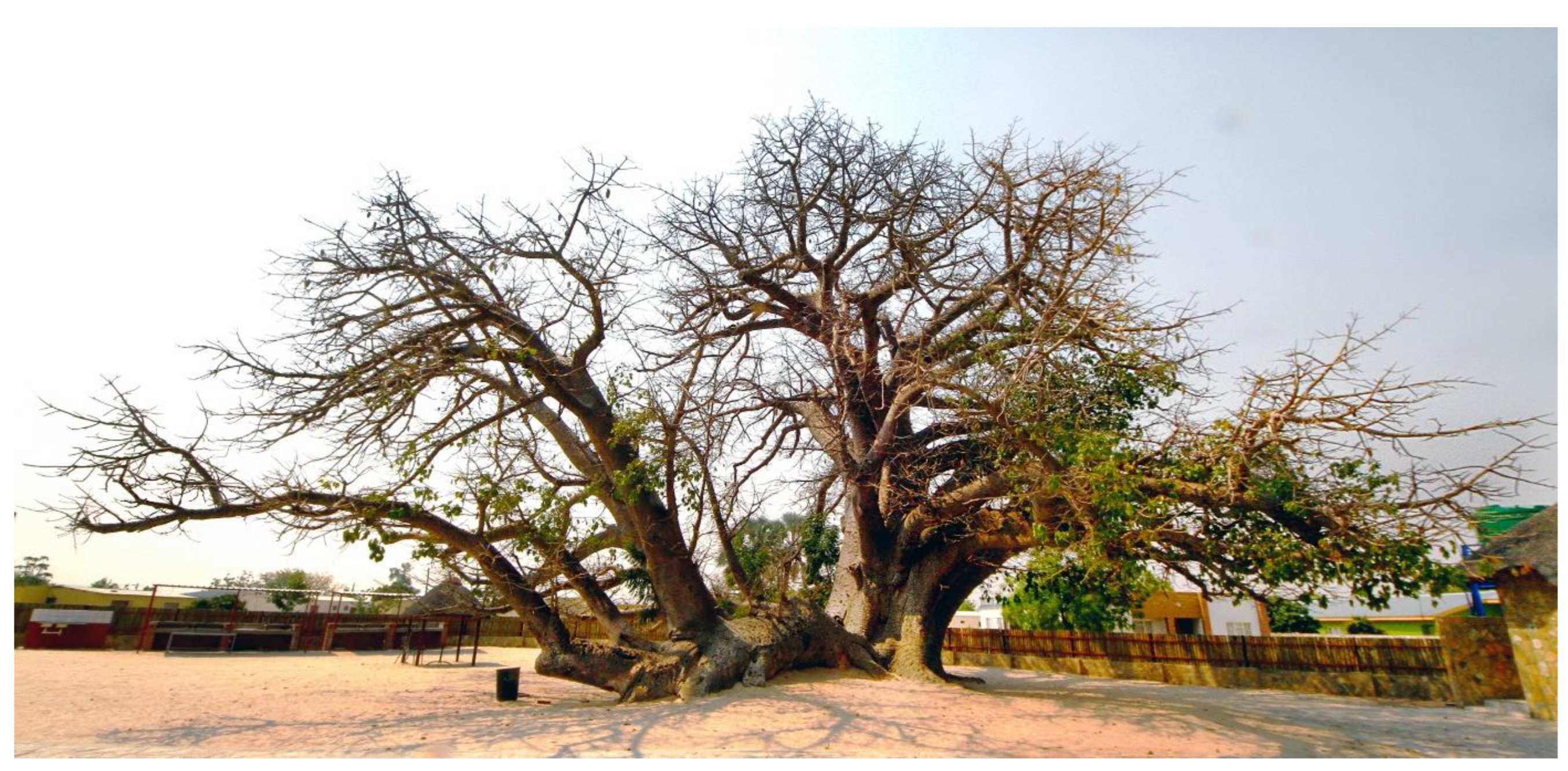
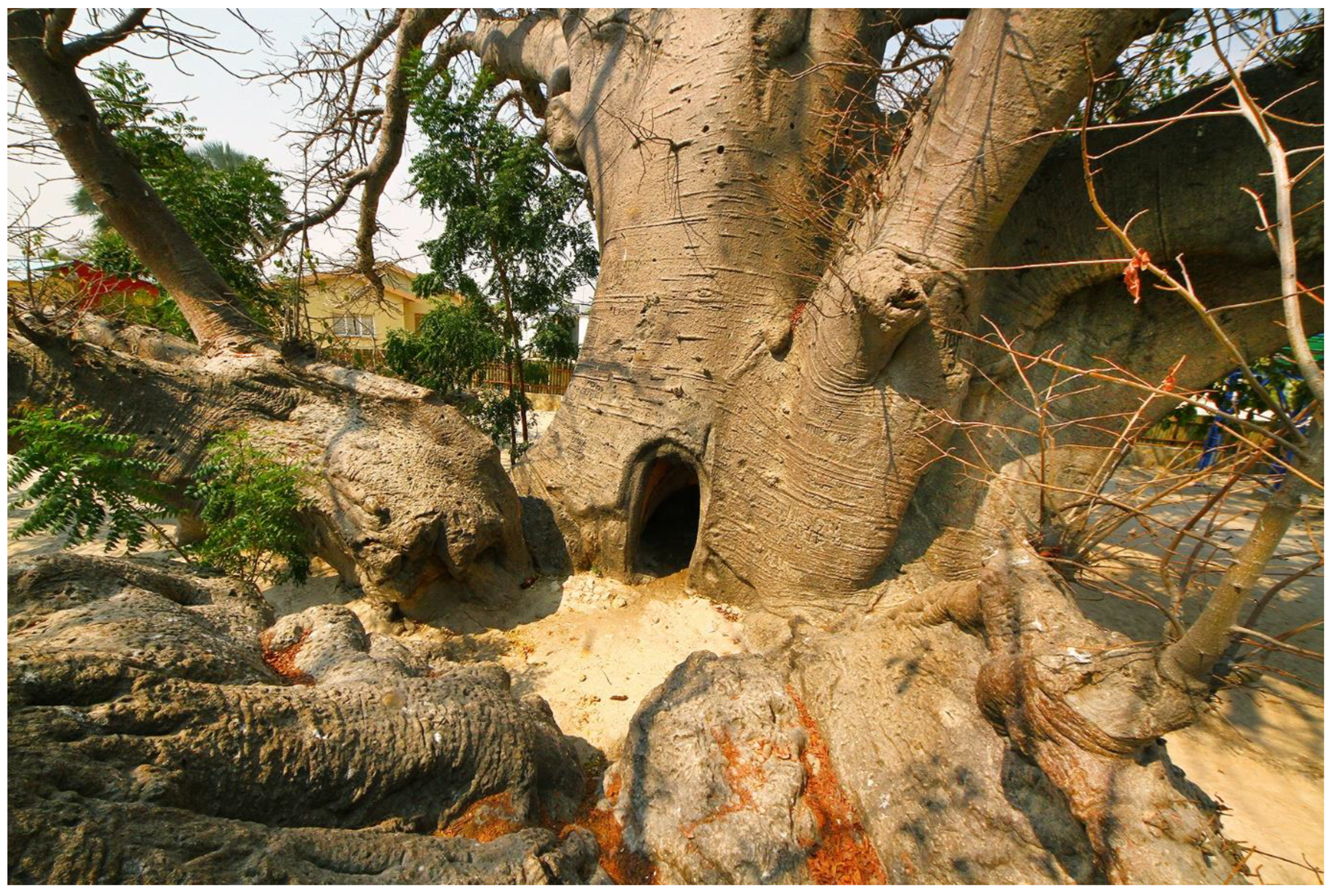
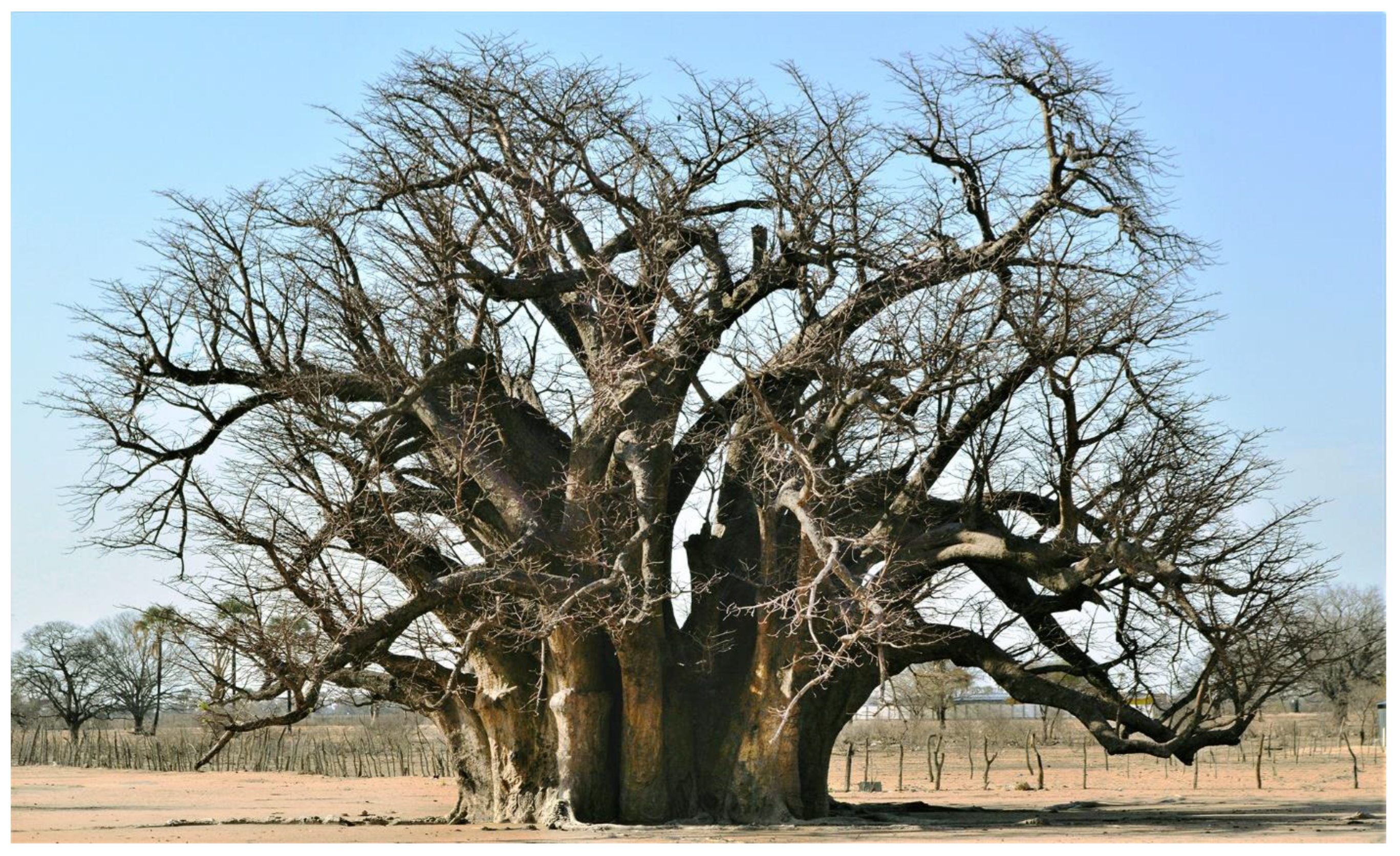
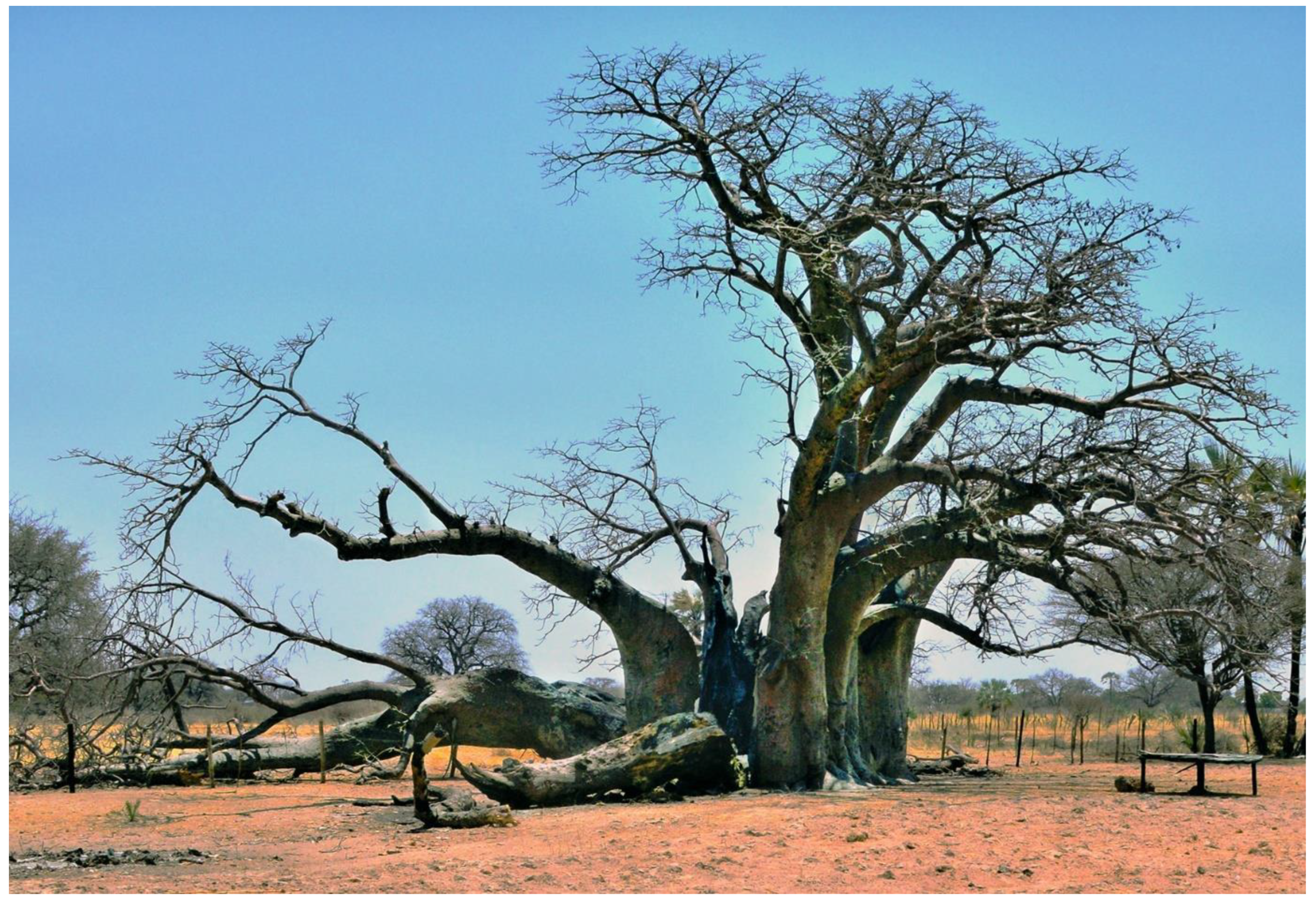

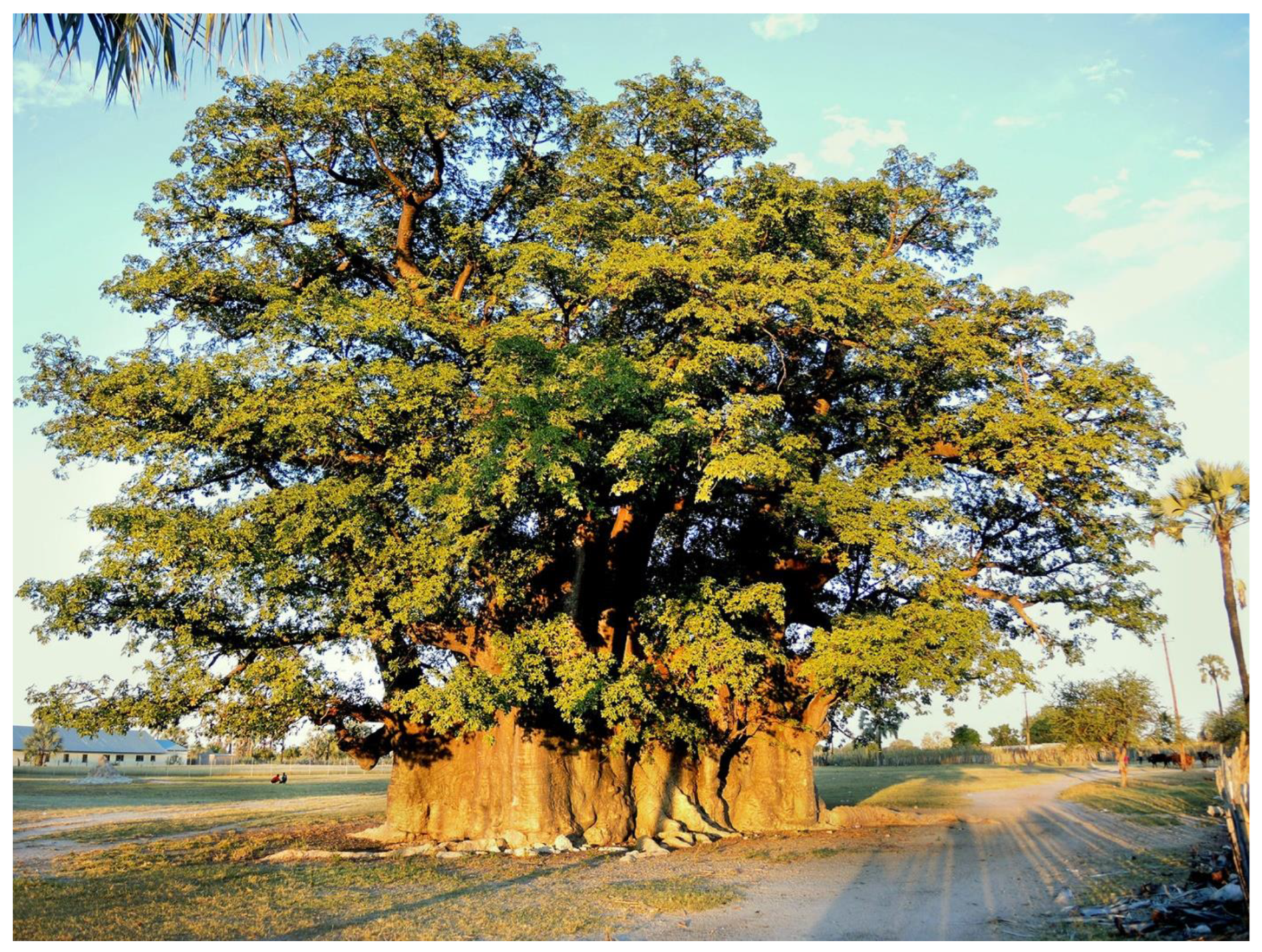
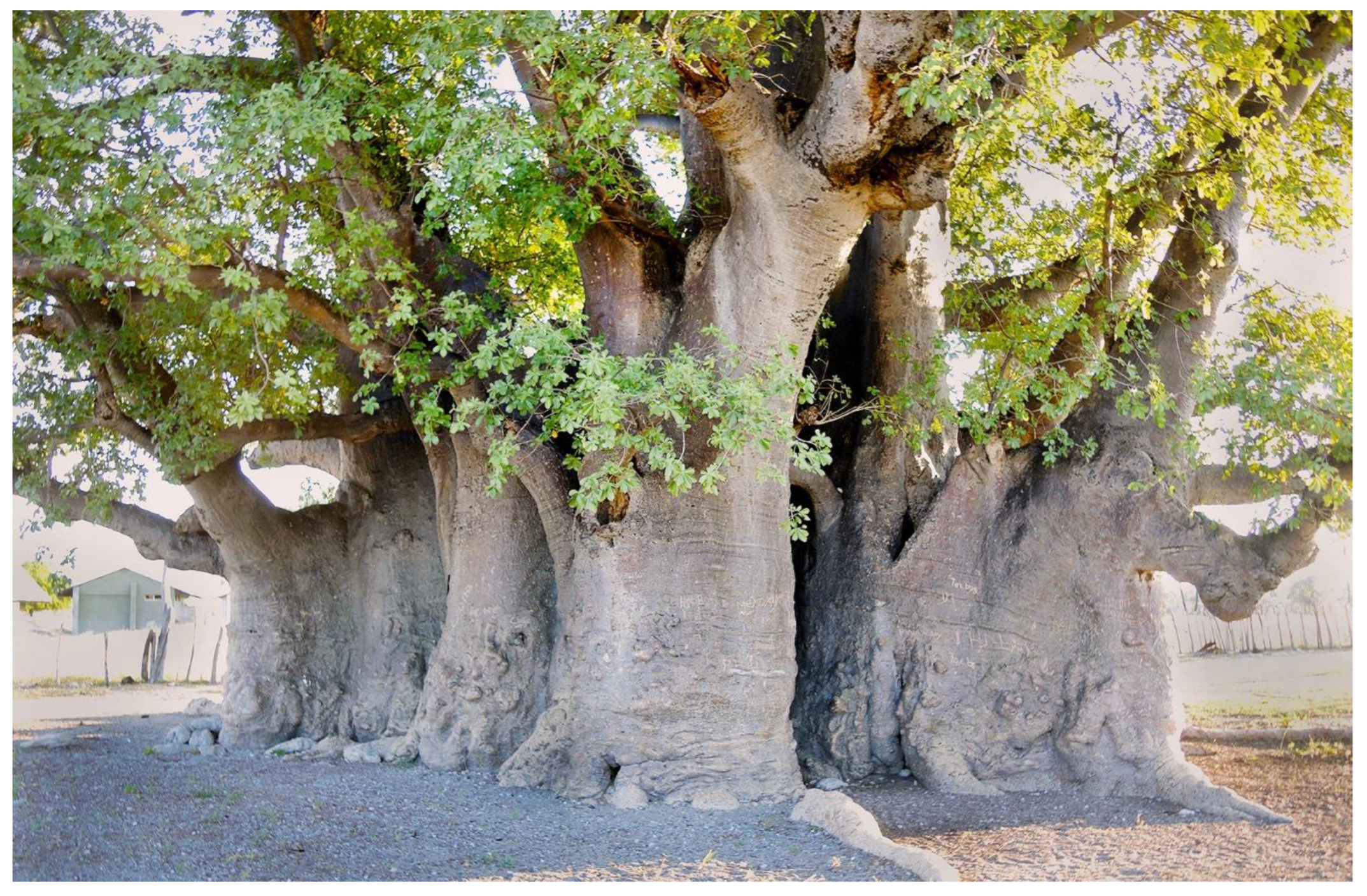
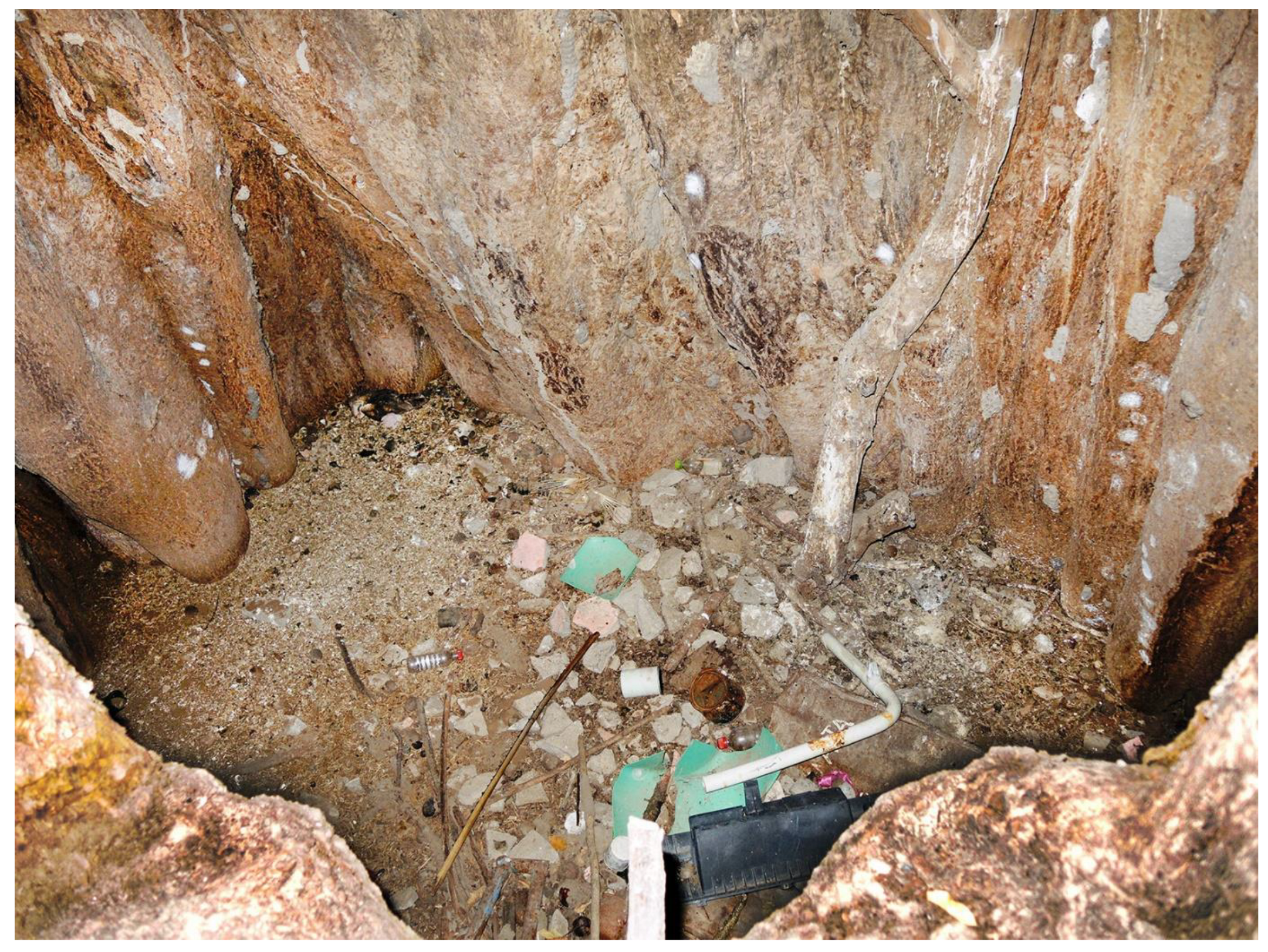

| Sample/ Segment Code | Depth 1 [Height 2] (m) | Radiocarbon Date [Error] (14C yr BP) | Cal CE Range 1σ [Confidence Interval] | Assigned Year [Error] (cal CE) | Sample/ Segment Age [Error] (cal CE) | Accession # |
|---|---|---|---|---|---|---|
| OMB-1a | 0.59 [1.32] | 679 [±19] | 1300–1324 (30.6%) 1346–1364 (22.9%) 1378–1390 (14.7%) | 1312 [±12] | 710 [±10] | OS-85751 |
| OMB-1b | 0.40 [1.32] | 335 [±23] | 1510–1550 (36.5%) 1560–1578 (14.1%) 1622–1640 (17.7%) | 1530 [±20] | 490 [±20] | OS-91318 |
| OMB-2 | 0.54 [1.30] | 646 [±26] | 1320–1354 (52.7%) 1386–1397 (16.4%) | 1337 [±17] | 685 [±15] | OS-85762 |
| OMB-3 | 0.30 [2.12] | 411 [±27] | 1459–1502 (47.9%) 1595–1615 (20.4%) | 1480 [±21] | 540 [±20] | OS-85142 |
| OKA-1 | 0.60 [0.75] | 604 [±22] | 1328–1338 (17.0%) 1392–1413 (51.3%) | 1402 [±10] | 620 [±10] | IT-C-2698 |
| OKA-2 | 0.54 [0.78] | 507 [±28] | 1429–1451 (68.3%) | 1440 [±11] | 580 [±10] | IT-C-1714 |
| OKA-3 | 0.66 [4.80] | 471 [±38] | 1431–1488 (68.3%) | 1459 [±28] | 565 [±30] | IT-C-2226 |
| AMA-1 | 0.68 [1.45] | 1067 [±35] | 988–1044 (68.3%) | 1016 [±28] | 1005 [±30] | IT-C-2223 |
| AMA-2 | 0.62 [1.48] | 923 [±25] | 1155–1210 (68.3%) | 1182 [±27] | 840 [±25] | IT-C-1685 |
| AMA-3 | 0.33 [2.05] | 625 [±20] | 1324–1345 (45.7%) 1391–1401 (16.1%) | 1334 [±10] | 690 [±10] | IT-C-2225 |
| HOW-1 | 0.66 [1.51] | 648 [±17] | 1322–1352 (57.3%) 1388–1394 (10.9%) | 1337 [±15] | 685 [±15] | OS-136722 |
| HOW-2 | 0.53 [1.54] | 443 [±23] | 1450–1496 (68.3%) | 1478 [±28] | 545 [±30] | OS-121267 |
| HOW-3 | 0.32 [2.40] | 342 [±20] | 1510–1550 (39.3%) 1560–1579 (17.1%) 1622–1635 (11.8%) | 1530 [±20] | 490 [±20] | OS-136086 |
Publisher’s Note: MDPI stays neutral with regard to jurisdictional claims in published maps and institutional affiliations. |
© 2022 by the authors. Licensee MDPI, Basel, Switzerland. This article is an open access article distributed under the terms and conditions of the Creative Commons Attribution (CC BY) license (https://creativecommons.org/licenses/by/4.0/).
Share and Cite
Patrut, A.; Patrut, R.T.; Rakosy, L.; Rakosy, D.; Oliver, W.; Ratiu, I.A.; Lowy, D.A.; Shiimbi, G.; Woodborne, S.; von Reden, K.F. Radiocarbon Investigation of the Historic African Baobabs of Omusati, Namibia. Forests 2022, 13, 1899. https://doi.org/10.3390/f13111899
Patrut A, Patrut RT, Rakosy L, Rakosy D, Oliver W, Ratiu IA, Lowy DA, Shiimbi G, Woodborne S, von Reden KF. Radiocarbon Investigation of the Historic African Baobabs of Omusati, Namibia. Forests. 2022; 13(11):1899. https://doi.org/10.3390/f13111899
Chicago/Turabian StylePatrut, Adrian, Roxana T. Patrut, Laszlo Rakosy, Demetra Rakosy, Willie Oliver, Ileana Andreea Ratiu, Daniel A. Lowy, Gebhardt Shiimbi, Stephan Woodborne, and Karl F. von Reden. 2022. "Radiocarbon Investigation of the Historic African Baobabs of Omusati, Namibia" Forests 13, no. 11: 1899. https://doi.org/10.3390/f13111899
APA StylePatrut, A., Patrut, R. T., Rakosy, L., Rakosy, D., Oliver, W., Ratiu, I. A., Lowy, D. A., Shiimbi, G., Woodborne, S., & von Reden, K. F. (2022). Radiocarbon Investigation of the Historic African Baobabs of Omusati, Namibia. Forests, 13(11), 1899. https://doi.org/10.3390/f13111899






